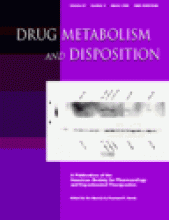Abstract
Fluconazole is increasingly used in children receiving chemotherapy. Many of these patients are being treated with cyclophosphamide, which must undergo hepatic metabolism to produce active alkylating species. As a consequence of the cytochrome P-450 inhibitory properties of fluconazole, a potential interaction exists between these two agents that could influence the therapeutic effect of cyclophosphamide. To investigate this interaction, a retrospective case series of patients was chosen from a population of children with a previously established profile of cyclophosphamide metabolism. Twenty-two children who were not receiving other therapy known to influence drug metabolism were selected and analyzed in terms of fluconazole treatment; of these, nine were receiving fluconazole and thirteen were identified as controls. Study design was not randomized. The plasma clearance of cyclophosphamide was lower in patients receiving fluconazole [mean(SD) 2.4(0.71) versus 4.2(1.2) l/h/m2, p = .001]. In vitro studies were performed to characterize the interaction between fluconazole and cyclophosphamide in six human liver microsomes. The concentration of fluconazole required to reduce the production of 4-hydroxycyclophosphamide to 50% of control values (IC50) varied between 9 and 80 μM (median 38 μM). Further studies of the effect of fluconazole on 4-hydroxycyclophosphamide production in vivo are warranted to determine whether this interaction reduces the therapeutic effect of cyclophosphamide in clinical practice.
Footnotes
-
Send reprint requests to: Dr. S. M. Yule, Department of Haematology, Yorkhill NHS Trust, Glasgow G3 8SJ, United Kingdom.
-
This work was supported by the The Tyneside Leukaemia Research Fund and the North of England Childrens Cancer Research Fund.
- Abbreviations used are::
- P-450s
- cytochrome P-450 enzymes
- DCCP
- dechloroethylcyclophosphamide
- CX
- carboxyphosphamide
- mesna sodium
- 2-mercaptoethane sulphonate
- AUC
- area under the concentration-time curve
- Received May 26, 1998.
- Accepted November 16, 1998.
- The American Society for Pharmacology and Experimental Therapeutics
DMD articles become freely available 12 months after publication, and remain freely available for 5 years.Non-open access articles that fall outside this five year window are available only to institutional subscribers and current ASPET members, or through the article purchase feature at the bottom of the page.
|






